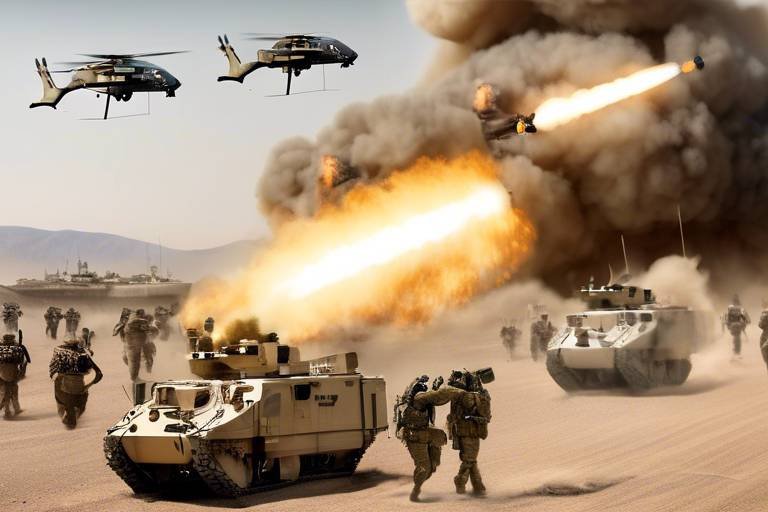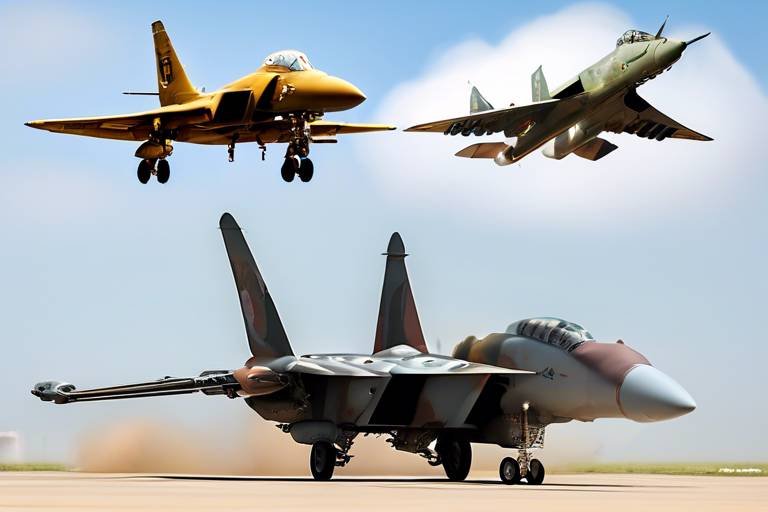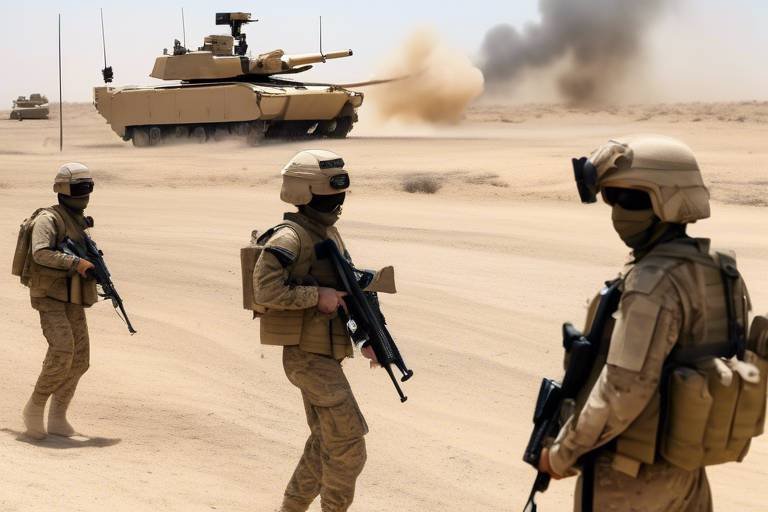How Advanced Simulation Tools Enhance Defense Training
In today's fast-paced world, the landscape of defense training is evolving at an unprecedented rate. With the rise of advanced simulation tools, military training is becoming more effective, efficient, and realistic than ever before. These tools are not just fancy gadgets; they represent a paradigm shift in how armed forces prepare for real-world challenges. Imagine soldiers training in a virtual battlefield, experiencing scenarios that closely mimic actual combat situations without the inherent risks. This is not science fiction—it's the new reality of defense training.
As we delve deeper into this topic, it's essential to understand that advanced simulation tools come with a multitude of benefits. They offer a level of cost-effectiveness that traditional training methods simply cannot match. By reducing the need for expensive live exercises and minimizing wear and tear on equipment, these tools allow defense organizations to allocate their resources more strategically. Furthermore, the enhanced realism provided by simulations enables trainees to engage in diverse environments, from urban landscapes to remote terrains, all while honing their skills in a controlled setting.
But what exactly are these advanced simulation tools? They range from virtual reality (VR) systems that immerse trainees in lifelike scenarios to live-action simulations that involve real personnel and equipment. Each type of simulation serves a unique purpose, catering to various training needs. For instance, VR simulations are particularly effective in combat training, allowing soldiers to practice critical decision-making and tactical skills without the risks associated with live exercises. This not only enhances learning outcomes but also builds confidence and competence.
Moreover, the integration of these simulation tools with other cutting-edge technologies, such as artificial intelligence (AI) and data analytics, is pushing the boundaries of what's possible in defense training. By analyzing performance metrics, these systems can offer personalized training experiences tailored to individual needs, ensuring that every trainee gets the most out of their time in the simulation. It's like having a personal coach who understands your strengths and weaknesses and helps you improve where it matters most.
However, the journey towards fully implementing these advanced tools is not without its challenges. One of the most significant hurdles is the initial cost associated with acquiring and setting up these technologies. Defense organizations must carefully weigh the long-term benefits against the upfront expenses to justify their investment. It's a bit like buying a high-end sports car; the initial price tag may be steep, but the performance and efficiency gains can make it worthwhile in the long run.
Additionally, ensuring that personnel are adequately trained to use these advanced simulation tools is crucial for successful integration. This requires ongoing support and resources to facilitate adaptation within existing defense training frameworks. Just as a pilot must log hours in a flight simulator before taking to the skies, military personnel must become proficient in using these tools to maximize their effectiveness.
Looking ahead, the future of defense training is incredibly promising. With continuous advancements in simulation technology, we can expect to see more innovative, efficient, and effective training methodologies emerge. These developments will undoubtedly enhance military preparedness for evolving threats, ensuring that our armed forces remain ready to respond to any challenge that comes their way.
- What are advanced simulation tools?
Advanced simulation tools are technologies that create realistic training environments for military personnel, allowing them to practice skills and decision-making in a safe yet immersive setting. - How do virtual reality simulations enhance training?
Virtual reality simulations immerse trainees in lifelike scenarios, helping them develop critical skills without the risks associated with live training exercises. - What are the challenges of implementing simulation tools?
Key challenges include high initial costs, the need for specialized training, and potential resistance to change within established training programs. - What is the future of defense training with simulation tools?
The future looks bright, with advancements in technology paving the way for more effective and efficient training methodologies that enhance military preparedness.

Benefits of Advanced Simulation Tools
Advanced simulation tools are revolutionizing the way defense training is conducted, offering a plethora of benefits that enhance the overall effectiveness of military preparedness. One of the most significant advantages is cost-effectiveness. Traditional training exercises often require extensive resources, including personnel, equipment, and logistics. In contrast, simulation tools allow for realistic training scenarios without the hefty price tag associated with live exercises. This means that defense organizations can allocate their budgets more efficiently, ensuring that training remains robust without breaking the bank.
Another key benefit is the enhanced realism that these tools provide. Modern simulations are designed to mimic real-world environments and situations, giving trainees the chance to experience lifelike scenarios. This immersion is crucial for developing not just technical skills but also the decision-making and tactical abilities needed in high-pressure situations. Imagine being able to practice in a virtual battlefield that reacts to your every move—this is the kind of realism that advanced simulation tools bring to the table.
Moreover, the ability to conduct training in diverse environments is another major advantage. Whether it's a desert, urban landscape, or a maritime setting, simulations can replicate various scenarios that soldiers may encounter in the field. This flexibility ensures that defense personnel are better prepared for any situation, enhancing their readiness and adaptability. By training in different environments, soldiers can develop a broader skill set and learn to think on their feet.
In addition to these practical benefits, advanced simulation tools also foster a culture of continuous learning. With the integration of data analytics and performance metrics, trainers can assess individual and team performance in real time. This feedback loop allows for tailored training experiences, where weaknesses can be addressed, and strengths can be further developed. The result? A more competent and confident defense force ready to tackle evolving threats.
To sum it up, the benefits of advanced simulation tools in defense training are multifaceted. From cost savings and enhanced realism to the ability to train in diverse environments and foster continuous learning, these tools are paving the way for a more effective military training paradigm. As technology continues to advance, the potential for these tools to further enhance military preparedness is truly exciting.

Types of Simulation Tools Used
In the realm of defense training, the variety of simulation tools available is as diverse as the challenges military personnel face. Each tool is designed to meet specific training objectives, ensuring that soldiers are well-prepared for any scenario they might encounter in the field. These tools can be broadly categorized into two main types: virtual reality (VR) simulations and live action simulations. Each type offers unique benefits and serves different training needs, making them indispensable in modern military training programs.
Let's dive deeper into these categories. Virtual reality simulations are at the forefront of technological advancements in military training. They create immersive environments where trainees can engage in lifelike scenarios that replicate real-world challenges. Imagine strapping on a VR headset and being transported to a battlefield where you must make split-second decisions. This level of immersion not only enhances the realism of training but also promotes better retention of skills and knowledge.
On the other hand, live action simulations bring a different flavor to training. These involve real personnel and equipment, allowing soldiers to experience the dynamics of teamwork and communication in a controlled environment. For instance, during a live action exercise, soldiers might conduct a mock mission where they must coordinate their actions while dealing with simulated threats. This hands-on experience is crucial for fostering the camaraderie and trust that are essential for operational success.
To illustrate the differences between these two types of simulation tools, consider the following table:
| Simulation Type | Key Features | Benefits |
|---|---|---|
| Virtual Reality Simulations |
|
|
| Live Action Simulations |
|
|
Both simulation types are integral to modern defense training, each addressing different aspects of military preparedness. By combining the strengths of both virtual reality and live action simulations, defense organizations can create a comprehensive training curriculum that equips personnel with the skills they need to succeed in various operational environments. As technology continues to evolve, we can expect even more innovative tools to emerge, further enhancing the training experience for our military forces.
Q1: What are the primary advantages of using simulation tools in defense training?
A1: Simulation tools offer cost-effectiveness, enhanced realism, and the ability to conduct training in diverse environments, ultimately improving the readiness of defense personnel.
Q2: How do virtual reality simulations differ from live action simulations?
A2: Virtual reality simulations provide immersive, controlled environments for decision-making practice, while live action simulations involve real personnel and equipment, fostering teamwork and communication skills.
Q3: Are there any challenges associated with implementing advanced simulation tools?
A3: Yes, challenges include high initial costs, the need for specialized training, and potential resistance to change within established defense training programs.

Virtual Reality Simulations
Virtual reality (VR) simulations are revolutionizing the way defense training is conducted. Imagine stepping into a lifelike environment where you can engage in realistic scenarios that mimic real-world challenges. This immersive experience allows trainees to practice critical decision-making and tactical skills without the inherent risks associated with traditional training methods. In essence, VR serves as a safe playground for soldiers to hone their abilities.
One of the most significant advantages of VR simulations is their ability to create a controlled yet realistic environment. Trainees can experience a variety of scenarios—from urban warfare to complex rescue missions—while feeling the pressure of real-time decision making. This level of immersion is crucial for developing the mental resilience and adaptability that modern military operations demand. The simulated environments can be tailored to reflect different terrains and conditions, ensuring that soldiers are prepared for any situation they might face on the battlefield.
Furthermore, VR simulations facilitate repetitive practice, which is essential for mastering skills. Just as athletes practice their moves repeatedly to achieve perfection, military personnel can engage in VR training multiple times, refining their techniques and strategies. This not only enhances individual performance but also promotes team cohesion, as soldiers can train together in these virtual settings, fostering communication and collaboration.
Another exciting aspect of VR in defense training is its potential for integration with emerging technologies. By combining VR with artificial intelligence (AI) and data analytics, training experiences can be personalized to meet each soldier's unique needs. For instance, AI can analyze a trainee's performance in real-time, providing immediate feedback and adjusting the difficulty level of scenarios accordingly. This adaptability ensures that every training session is both challenging and relevant to the individual's skill level.
To illustrate the impact of VR simulations, consider the following table that compares traditional training methods with VR training:
| Aspect | Traditional Training | Virtual Reality Training |
|---|---|---|
| Risk Level | High | Low |
| Cost | Higher (due to equipment and personnel costs) | Lower (long-term savings on resources) |
| Realism | Moderate | High |
| Repetitive Practice | Limited | Unlimited |
| Personalization | Minimal | High (using AI) |
In conclusion, virtual reality simulations are not just a trend; they are a game changer in defense training. By providing a safe, realistic, and adaptable training environment, VR equips soldiers with the skills and confidence they need to succeed in high-pressure situations. As technology continues to advance, the possibilities for VR in military training are virtually limitless, paving the way for a more prepared and effective defense force.
- What are virtual reality simulations?
Virtual reality simulations are immersive training environments that use VR technology to create realistic scenarios for military personnel to practice their skills. - How do VR simulations improve training outcomes?
They provide a safe space for soldiers to practice decision-making and tactical skills, enhancing learning and retention through realistic experiences. - Can VR simulations be customized for individual training needs?
Yes, by integrating AI and data analytics, VR simulations can be tailored to meet the specific needs and performance metrics of each trainee. - Are there any risks associated with VR training?
While VR training significantly reduces physical risks, there may be some initial discomfort or disorientation as trainees adjust to the immersive experience.

Applications in Combat Training
The integration of advanced simulation tools in combat training has revolutionized the way military personnel prepare for real-world scenarios. Imagine stepping into a virtual battlefield where every sound, sight, and tactical decision feels incredibly real. This is the power of virtual reality simulations. They provide soldiers with the opportunity to engage in intense combat situations without the inherent risks associated with live-fire exercises. In this controlled environment, trainees can make mistakes, learn from them, and refine their skills without endangering lives.
One of the most significant advantages of using simulation tools in combat training is the ability to replicate varied combat scenarios. From urban warfare to open-field engagements, these simulations can be tailored to reflect a wide range of environments and conditions. This adaptability ensures that soldiers are not only prepared for the expected but are also equipped to handle the unforeseen challenges they may face in the field. By immersing soldiers in these realistic scenarios, they can develop critical skills such as decision-making, situational awareness, and teamwork.
Moreover, virtual reality simulations can incorporate real-time feedback and analytics, allowing trainers to monitor performance and provide immediate guidance. This feedback loop is invaluable; it enables trainees to understand their strengths and weaknesses, fostering an environment of continuous improvement. For instance, after a simulation, a debriefing session can analyze the decisions made during the exercise, highlighting what went well and what could be improved. This practice not only enhances individual performance but also builds a cohesive unit capable of functioning effectively under pressure.
Another exciting aspect of these simulations is their ability to integrate with other technologies, such as artificial intelligence and data analytics. By leveraging AI, simulations can adapt in real-time to the actions of the trainees, creating a more dynamic and unpredictable training environment. This unpredictability mirrors the chaos of actual combat, helping soldiers to think on their feet and adapt their strategies as the situation evolves. Additionally, data analytics can track performance over time, allowing for personalized training regimens that cater to each soldier's unique needs and learning curves.
In summary, the applications of advanced simulation tools in combat training are not just beneficial; they are transformative. By providing realistic, immersive experiences that emphasize critical skills and adaptability, these technologies prepare soldiers for the complexities of modern warfare. As military training continues to evolve, the role of simulation tools will undoubtedly expand, leading to even more innovative approaches to defense readiness.
- What are advanced simulation tools? Advanced simulation tools are technologies used to create realistic training environments for military personnel, allowing them to practice skills in a safe and controlled setting.
- How do virtual reality simulations enhance combat training? Virtual reality simulations immerse soldiers in lifelike scenarios, helping them develop decision-making and tactical skills without the risks of live training exercises.
- What challenges are associated with implementing simulation tools? Challenges include high initial costs, the need for specialized training, and potential resistance to change within existing training programs.
- What is the future of defense training with simulation tools? The future looks promising, with continuous advancements in technology leading to more innovative and effective training methodologies.

Integration with Other Technologies
Integrating advanced simulation tools with other cutting-edge technologies is revolutionizing defense training in ways we could only dream of a few years ago. Imagine a training environment where virtual reality (VR) simulations are enhanced by artificial intelligence (AI) and data analytics. This combination not only makes training more immersive but also allows for a tailored experience that adapts to the unique needs of each trainee. For instance, AI can analyze a trainee's performance in real-time, providing instant feedback and adjusting the difficulty of scenarios to match their skill level. This personalized approach ensures that every soldier, regardless of their starting point, can achieve their maximum potential.
Moreover, the integration of data analytics plays a crucial role in this ecosystem. By collecting and analyzing vast amounts of data from training sessions, defense organizations can identify trends, strengths, and weaknesses in both individual and team performances. This data-driven insight enables trainers to refine their programs continually, ensuring that they remain relevant and effective in preparing personnel for the complexities of modern warfare.
To illustrate the impact of these integrations, let's take a closer look at how these technologies work together:
| Technology | Function | Benefits |
|---|---|---|
| Virtual Reality | Immersive training environments | Enhanced realism, safe practice of high-stakes scenarios |
| Artificial Intelligence | Real-time performance analysis | Personalized training, adaptive difficulty |
| Data Analytics | Performance trend analysis | Informed decision-making for training programs |
This synergy not only boosts the effectiveness of training but also fosters a culture of continuous improvement within defense forces. As trainees engage with these advanced tools, they develop a deeper understanding of their roles and responsibilities, leading to better preparedness when facing real-world challenges.
In conclusion, the integration of advanced simulation tools with AI and data analytics is a game-changer for defense training. It transforms how soldiers learn, adapt, and prepare for the battlefield, ensuring that they are not just trained but are ready to tackle the complexities of modern combat scenarios.
- What are advanced simulation tools? Advanced simulation tools are technologies used to create realistic training environments for defense personnel, allowing them to practice skills in a controlled setting.
- How does virtual reality enhance training? Virtual reality immerses trainees in lifelike scenarios, enabling them to practice decision-making and tactical skills without the risks of real-life training.
- What role does AI play in defense training? AI analyzes trainee performance in real-time, providing personalized feedback and adjusting training scenarios to better suit individual needs.
- Are there challenges in implementing these technologies? Yes, challenges include high initial costs, the need for specialized training, and potential resistance to change within established training programs.

Live Action Simulations
Live action simulations represent a dynamic and immersive approach to defense training, where real personnel and equipment come together in a controlled environment to replicate the complexities of actual combat situations. These simulations are not just about putting on a show; they are meticulously designed to foster teamwork, enhance communication skills, and develop critical operational capabilities among military personnel. Imagine a scenario where soldiers are tasked with navigating through a simulated urban battlefield, encountering unexpected challenges that require quick thinking and collaboration. This is where live action simulations truly shine.
One of the key advantages of live action simulations is their ability to provide participants with hands-on experience. Unlike theoretical training methods, these simulations allow soldiers to engage in realistic exercises that closely mimic the conditions they would face in the field. This experiential learning is invaluable, as it helps to bridge the gap between classroom instruction and real-world application. For instance, during a live action simulation, soldiers might be required to execute a tactical maneuver while under simulated enemy fire, forcing them to apply their training in a high-pressure environment.
Moreover, live action simulations can be tailored to address specific training objectives. Whether it's practicing urban warfare tactics, conducting search and rescue operations, or improving crisis response capabilities, these simulations can be designed to meet a variety of training needs. The flexibility of live action training allows commanders to create scenarios that reflect current operational challenges, ensuring that troops are always prepared for the unexpected.
However, it's essential to recognize that live action simulations also come with their own set of challenges. Safety is a paramount concern, and extensive planning is required to mitigate risks associated with live exercises. This involves detailed briefings, safety protocols, and sometimes even the presence of medical personnel on-site. The planning process can be resource-intensive, but the benefits of effective training often outweigh the costs.
In summary, live action simulations are a cornerstone of modern defense training, providing soldiers with the opportunity to practice their skills in realistic scenarios. By cultivating teamwork, enhancing communication, and offering practical experience, these simulations play a critical role in preparing military personnel for the challenges they will face in real-world operations.
- What are live action simulations?
Live action simulations involve real personnel and equipment in training exercises, designed to replicate real-world combat scenarios. - How do live action simulations enhance training?
They provide hands-on experience, foster teamwork, and improve communication skills, all essential for operational success. - What are the safety measures in place during live action simulations?
Extensive planning, safety protocols, and sometimes medical personnel are present to ensure the safety of all participants. - Can live action simulations be tailored to specific training needs?
Yes, they can be designed to reflect current operational challenges and meet various training objectives.

Challenges in Implementation
While the advantages of advanced simulation tools in defense training are clear, the journey toward their implementation is not without its hurdles. One of the most significant challenges is the high initial costs associated with acquiring and setting up these sophisticated systems. For many defense organizations, the budget constraints can lead to tough decisions about where to allocate resources. It's like trying to buy a luxury sports car when you’re on a budget; the allure is strong, but the price tag can be daunting. Organizations must weigh the long-term benefits of improved training outcomes against the substantial upfront investment required.
In addition to financial considerations, there is also the need for specialized training to effectively utilize these advanced tools. Defense personnel must be equipped with the necessary skills to operate simulation technologies, which often means investing in additional education and training programs. This can be a time-consuming process, and without proper support, personnel may struggle to adapt to new systems. Imagine learning to fly a plane; it’s not just about knowing how to push buttons, but understanding the entire operation. Similarly, successful integration of simulation tools requires a deep understanding of their functionalities and capabilities.
Moreover, there can be resistance to change within established defense training programs. Just like any organization, military institutions can be set in their ways, preferring traditional methods that have proven effective over the years. This reluctance can stem from a variety of factors, including fear of the unknown or a belief that new technologies may not be as effective as conventional training. Overcoming this resistance requires strong leadership and a clear demonstration of the tangible benefits that simulation tools can provide.
To better understand the challenges organizations face, let's take a look at a table summarizing some of the key implementation challenges:
| Challenge | Description |
|---|---|
| High Initial Costs | The significant upfront investment required for advanced simulation technologies can deter organizations from adopting them. |
| Specialized Training Needs | Personnel must receive adequate training to effectively utilize simulation tools, which can be time-consuming and resource-intensive. |
| Resistance to Change | Established training programs may resist the integration of new technologies, preferring traditional methods. |
In conclusion, while the promise of advanced simulation tools in defense training is enticing, organizations must navigate these challenges thoughtfully. By addressing cost concerns, prioritizing training, and fostering a culture open to innovation, defense agencies can unlock the full potential of these transformative technologies.
- What are advanced simulation tools? Advanced simulation tools are technologies used to create lifelike training environments for defense personnel, enhancing their skills and readiness.
- Why are these tools important in defense training? They provide realistic scenarios that help trainees develop critical decision-making and tactical skills without the risks associated with live exercises.
- What challenges do organizations face when implementing these tools? Key challenges include high initial costs, the need for specialized training, and resistance to change within established programs.
- How can organizations overcome these challenges? By demonstrating the long-term benefits, investing in training, and fostering a culture of innovation, organizations can effectively integrate simulation tools.

Cost Considerations
When it comes to implementing advanced simulation tools in defense training, one of the most pressing concerns is the initial investment. The cost of advanced simulation technologies can be quite significant, often leading defense organizations to engage in extensive cost-benefit analyses. This process isn't just about looking at the price tag; it's about weighing the long-term benefits against the upfront expenses. For instance, while the initial costs may seem daunting, the potential for improved training outcomes and operational readiness can justify the investment.
Moreover, it's essential to consider the total cost of ownership, which encompasses not only the purchase price of the simulation tools but also ongoing maintenance, updates, and necessary training for personnel. Organizations must factor in these additional costs to develop a comprehensive understanding of what the investment truly entails. To illustrate this point, let's break down some of the cost components:
| Cost Component | Description |
|---|---|
| Initial Purchase | The upfront cost of acquiring simulation tools and technologies. |
| Maintenance | Regular updates and repairs to ensure the tools remain functional and effective. |
| Training | Investing in training programs for personnel to effectively use the tools. |
| Support Services | Ongoing technical support to troubleshoot and resolve issues. |
In addition to these factors, organizations must also consider the potential for scalability. As military needs evolve, the ability to adapt and expand simulation capabilities can lead to further costs. However, the right simulation tools can provide a flexible platform that scales with changing requirements, ultimately saving money in the long run.
Despite the financial challenges, many defense organizations are recognizing that the benefits of advanced simulation tools—such as enhanced training effectiveness, reduced risk during training exercises, and improved operational readiness—far outweigh the initial costs. In a world where military preparedness is paramount, investing in the right technologies can mean the difference between success and failure in critical situations.
- What are advanced simulation tools? Advanced simulation tools are technologies that create realistic training environments for defense personnel, allowing them to practice skills and decision-making in controlled scenarios.
- Why are cost considerations important? Cost considerations are crucial because they help organizations assess the feasibility of implementing new technologies against their long-term benefits and operational needs.
- How can organizations justify the initial investment? Organizations can justify the investment by demonstrating the potential for improved training outcomes, reduced risks, and long-term cost savings through enhanced operational readiness.

Training and Adaptation
Integrating advanced simulation tools into defense training is not just about introducing new technology; it’s about transforming the entire training paradigm. To ensure that personnel can effectively utilize these tools, a robust training and adaptation process is essential. This involves not only familiarizing users with the technology itself but also adapting existing training frameworks to fully leverage the capabilities that these advanced tools offer.
First and foremost, comprehensive training programs must be established. This means providing in-depth instruction on how to operate the simulation tools, as well as understanding their applications in real-world scenarios. It’s crucial that trainees feel confident and competent when using these tools, as their effectiveness directly correlates with the quality of the training experience. Additionally, ongoing support is vital. As technology evolves, so too must the training programs, ensuring that personnel are kept up-to-date with the latest advancements.
Moreover, it’s important to foster a culture of adaptability within defense organizations. Personnel should be encouraged to embrace new technologies and methodologies rather than resist them. This can be achieved through workshops, hands-on experiences, and open forums where personnel can share their experiences and feedback regarding the simulation tools. By creating an environment that values innovation and continuous learning, organizations can enhance the effectiveness of their training programs.
To illustrate the impact of effective training and adaptation, consider the following table that outlines key components of a successful implementation strategy:
| Component | Description |
|---|---|
| Comprehensive Training | In-depth instruction on simulation tools and their applications. |
| Ongoing Support | Continuous updates and assistance to keep personnel informed. |
| Cultural Adaptability | Encouraging acceptance and integration of new technologies. |
| Feedback Mechanisms | Platforms for personnel to share experiences and suggestions. |
Ultimately, the successful integration of advanced simulation tools into defense training hinges on a commitment to . By investing in these areas, defense organizations can ensure that their personnel are not just equipped with cutting-edge technology but are also prepared to face the challenges of modern warfare with confidence and skill.
- What are advanced simulation tools? Advanced simulation tools are technologies that provide realistic training environments, allowing defense personnel to practice skills in a controlled setting.
- How do these tools improve training outcomes? They enhance realism, allow for diverse training scenarios, and enable personalized training experiences.
- What challenges are associated with implementing these tools? Challenges include high initial costs, the need for specialized training, and potential resistance to change within organizations.
- What is the future of defense training with these tools? The future looks promising with continuous advancements leading to more innovative and effective training methodologies.

The Future of Defense Training
The future of defense training is not just bright; it's downright revolutionary! As technology continues to evolve at breakneck speed, the military is poised to harness these advancements to create training environments that are more immersive, efficient, and effective than ever before. Imagine a world where soldiers can engage in realistic combat scenarios without ever leaving a training facility. This is not science fiction; it's the future of defense training!
One of the most exciting developments on the horizon is the integration of augmented reality (AR) with existing simulation tools. AR can overlay digital information onto the physical world, allowing trainees to interact with both real and virtual elements seamlessly. This hybrid approach not only enhances realism but also provides immediate feedback, enabling soldiers to learn and adapt in real-time. For instance, a soldier could receive tactical instructions via AR glasses while navigating through a simulated mission, making the training experience more dynamic and engaging.
Additionally, the use of artificial intelligence (AI) in training programs is set to transform how military personnel learn and develop their skills. AI can analyze a trainee's performance, identify weaknesses, and suggest personalized training modules tailored to their specific needs. This level of customization can lead to faster learning curves and better preparedness, as soldiers will be equipped with the skills they need to face evolving threats on the battlefield.
Moreover, as we look toward the future, the concept of distributed training is gaining traction. This approach allows military personnel to train together, regardless of geographic location, using advanced simulation tools. Imagine soldiers from different countries collaborating in a virtual environment, honing their skills and strategies together. This not only fosters international cooperation but also prepares defense forces for joint operations in real-world scenarios.
However, it's essential to recognize that with these advancements come challenges. The need for continuous investment in technology, infrastructure, and training personnel is paramount. As we embrace these new tools, defense organizations must also ensure that they are not only investing in cutting-edge technology but also in the human element—the soldiers who will use these tools. Ensuring that personnel are well-trained and comfortable with new technologies is crucial for successful implementation.
In conclusion, the future of defense training is set to be transformative, with advanced simulation tools leading the charge. By integrating technologies like AR and AI, and promoting distributed training, military organizations can enhance their preparedness for the challenges of tomorrow. As we navigate this exciting frontier, one thing is clear: the military of the future will be better equipped, more adaptable, and more capable than ever before.
- What role does artificial intelligence play in defense training?
AI analyzes trainee performance and provides personalized training modules to enhance learning efficiency. - How does augmented reality improve training?
AR overlays digital information onto the physical environment, creating a more immersive and interactive training experience. - What is distributed training?
Distributed training allows military personnel to train together virtually, regardless of their physical locations, fostering collaboration and joint operational readiness. - What are the challenges of implementing advanced simulation tools?
Challenges include high initial costs, the need for specialized training, and the requirement for ongoing support and adaptation within existing training frameworks.
Frequently Asked Questions
- What are advanced simulation tools in defense training?
Advanced simulation tools are technologies that create realistic training environments for defense personnel. They include virtual reality, live-action simulations, and various other interactive platforms that allow soldiers to practice their skills in a safe yet immersive setting.
- How do these tools improve military preparedness?
These tools enhance military preparedness by providing realistic scenarios that help soldiers develop critical decision-making and tactical skills. By simulating diverse environments, trainees can experience a range of situations that they might face in real operations, ultimately improving their readiness.
- What types of simulation tools are commonly used?
Common types of simulation tools used in defense training include virtual reality simulations, which immerse users in lifelike scenarios, and live-action simulations that involve real personnel and equipment. Each type caters to different training needs and objectives.
- Are there any challenges in implementing these tools?
Yes, implementing advanced simulation tools can present challenges such as high initial costs, the necessity for specialized training, and potential resistance from personnel accustomed to traditional training methods. These factors can complicate the integration process.
- How do cost considerations affect the adoption of simulation technologies?
The upfront investment in advanced simulation technologies can be significant, leading defense organizations to weigh the long-term benefits against the initial costs. A thorough cost-benefit analysis is essential to justify the implementation of these tools.
- What is the future of defense training with simulation tools?
The future of defense training looks bright, with ongoing advancements in simulation technology promising more innovative and efficient training methodologies. These developments aim to keep pace with evolving threats and enhance the overall effectiveness of military training.



















